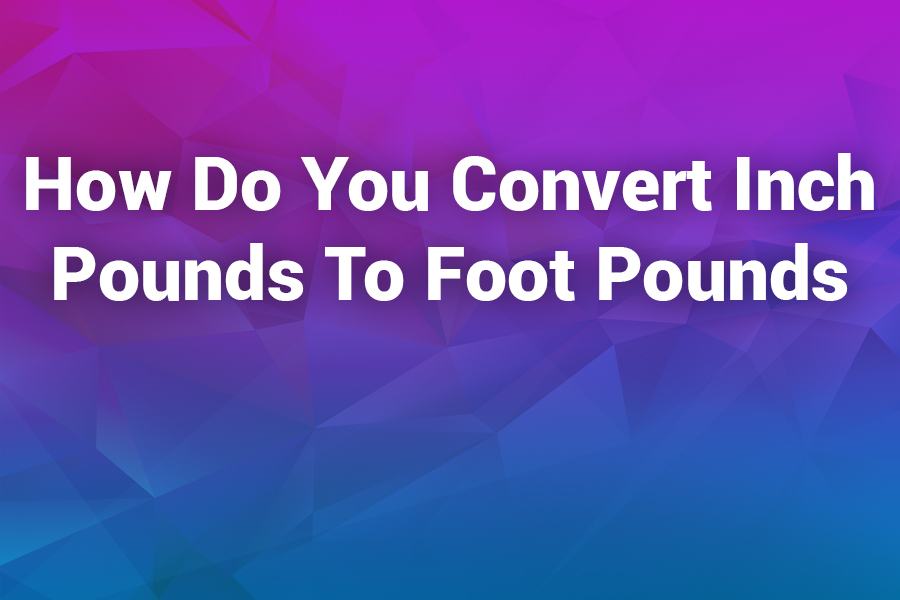Whether you’re tightening bolts on an engine, working on a bicycle, or assembling furniture, torque plays a critical role in applying the right amount of force. One of the most common questions professionals and DIYers ask is:
“How do you convert inch pounds to foot pounds?”
This conversion is crucial for ensuring you don’t over-tighten (or under-tighten) fasteners, which can lead to damage or safety risks. In this guide, we’ll break down what torque is, the difference between inch-pounds and foot-pounds, and how to convert between the two with confidence.
What Is Torque?
Torque is a measure of the rotational force applied to an object. It’s commonly used in mechanics, engineering, and everyday applications like automotive repairs or machinery assembly.
Common Torque Units:
- Inch-pounds (in-lb) – Used when smaller torque values are required, like in electronics or bicycle parts.
- Foot-pounds (ft-lb) – More common in automotive, construction, and industrial settings.
Note:
Both units measure torque but at different scales. Think of them like inches vs. feet — both measure length, but feet are larger units.
So, How Do You Convert Inch Pounds to Foot Pounds?
The conversion is simple once you understand the relationship between inches and feet.
✅ Conversion Formula:
mathematicaCopyEdit1 foot = 12 inches
Therefore, 1 ft-lb = 12 in-lb
So, to convert:
iniCopyEditFoot-pounds = Inch-pounds ÷ 12
✅ Example:
CopyEdit120 inch-pounds ÷ 12 = 10 foot-pounds
That’s it! If you’re wondering how do you convert inch pounds to foot pounds, just divide the inch-pounds by 12.
Quick Reference Table
| Inch-Pounds (in-lb) | Foot-Pounds (ft-lb) |
|---|---|
| 12 in-lb | 1 ft-lb |
| 24 in-lb | 2 ft-lb |
| 36 in-lb | 3 ft-lb |
| 60 in-lb | 5 ft-lb |
| 120 in-lb | 10 ft-lb |
| 240 in-lb | 20 ft-lb |
| 480 in-lb | 40 ft-lb |
Why Convert Torque Units?
You might ask — why bother converting torque values? Here are some real-world examples:
🔧 Automotive Repairs
Torque wrenches often use foot-pounds. But smaller components like valve covers might be specified in inch-pounds. If you apply foot-pounds instead of inch-pounds, you could snap the bolt or damage the part.
🔩 Precision Engineering
In robotics, electronics, or aerospace, inch-pounds are standard. Converting to foot-pounds helps when calibrating larger machines or comparing specs.
🛠️ Tool Compatibility
Some torque wrenches or torque drivers only support one unit. Knowing how to convert helps you use any tool accurately.
Real-World Example: Torque Conversion in Auto Repair
Imagine you’re installing a spark plug that requires 156 inch-pounds of torque. But your torque wrench only measures in foot-pounds. To find the equivalent:
CopyEdit156 in-lb ÷ 12 = 13 ft-lb
You would set your wrench to 13 foot-pounds.
Converting in the Opposite Direction
If you need to convert foot-pounds to inch-pounds, simply multiply by 12.
✅ Formula:
iniCopyEditInch-pounds = Foot-pounds × 12
✅ Example:
CopyEdit15 ft-lb × 12 = 180 in-lb
Tips for Accurate Torque Conversion
✅ Use a Digital Torque Converter
Instead of manual calculations, you can use tools like:
- MechanicalTorqueCalculator.com
- GramsToPounds.io (New torque converter section coming soon)
✅ Don’t Round Too Much
Over-rounding can throw off precision. Always keep at least one decimal for foot-pounds if converting from inch-pounds.
✅ Check the Tool Units
Before applying torque, verify if your torque wrench uses ft-lb or in-lb.
Common Mistakes to Avoid
- Confusing Units: Applying inch-pounds when the spec says foot-pounds (or vice versa).
- Not Using the Right Wrench: Using a foot-pound wrench for small inch-pound specs can lead to overtightening.
- Ignoring Calibration: Old torque wrenches can become inaccurate. Always calibrate or test before use.
When to Use Inch-Pounds vs. Foot-Pounds
| Application | Recommended Unit |
|---|---|
| Electronics | Inch-pounds |
| Bicycle Components | Inch-pounds |
| Automotive (spark plugs) | Inch-pounds |
| Lug Nuts, Engine Mounts | Foot-pounds |
| Construction Bolts | Foot-pounds |
Torque Conversion Chart (Extended)
| Inch-Pounds | Foot-Pounds |
|---|---|
| 10 in-lb | 0.83 ft-lb |
| 20 in-lb | 1.67 ft-lb |
| 50 in-lb | 4.17 ft-lb |
| 75 in-lb | 6.25 ft-lb |
| 90 in-lb | 7.5 ft-lb |
| 100 in-lb | 8.33 ft-lb |
| 150 in-lb | 12.5 ft-lb |
| 200 in-lb | 16.67 ft-lb |
| 300 in-lb | 25 ft-lb |
| 360 in-lb | 30 ft-lb |
Use this for quick estimates when converting torque specs.
FAQs About Torque Conversion
❓ How do you convert inch pounds to foot pounds?
Divide the inch-pound value by 12.
Example: 120 in-lb ÷ 12 = 10 ft-lb.
❓ Can I use a foot-pound wrench for inch-pound specs?
Not recommended unless the torque value is high and falls within the wrench’s range.
❓ Is there a tool to convert torque instantly?
Yes. Use a digital torque converter or a reliable tool site like gramstopounds.io.
❓ Why are inch-pounds used in small mechanics?
Because they allow for finer, more precise control in low-torque applications.
❓ Do digital torque wrenches switch between units?
Many do. Always check your tool’s user manual.
Conclusion: Convert Torque Accurately, Every Time
Now that you know how to convert inch pounds to foot pounds, you’ll be better prepared for any task involving torque. From mechanical repairs to home improvement and engineering projects, understanding this conversion ensures safety, precision, and better outcomes.

